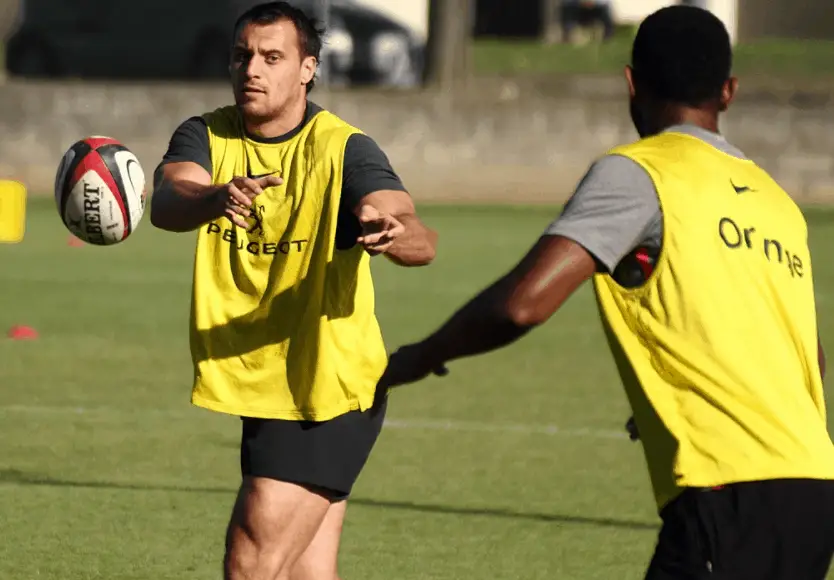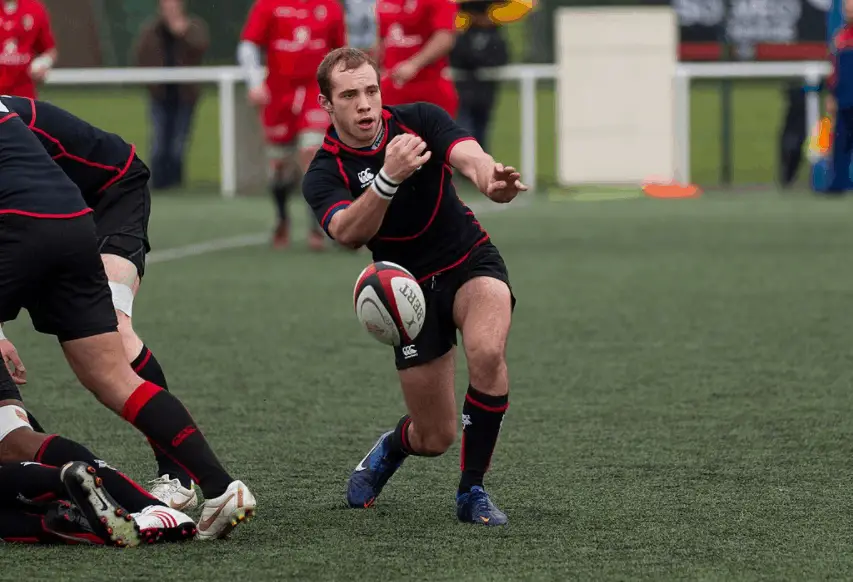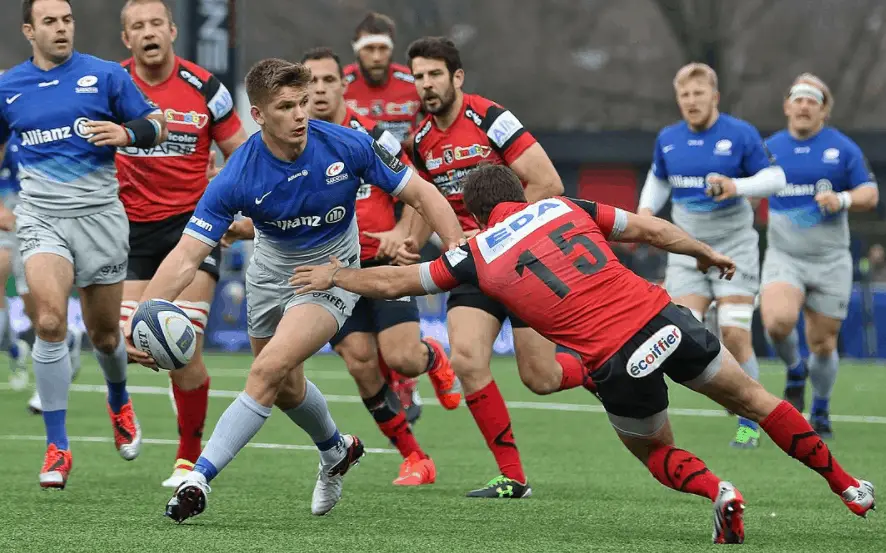Passing and catching a rugby ball is the most fundamental skill of the game, however, many newcomers to the game struggle to do so because they are never actually taught how to do so. With that in mind, I have put this little guide together. First we’ll cover the general rules of passing and catching and the we will look at the 6 different types of passes in detail.
How To Pass A Rugby Ball
Hold the ball in two hands out in front of you and run forward. Look in the direction you want to pass to and pick out the target. Draw the ball back slightly, in the opposite direction from which you are going to pass it, then swing the arms directly towards the target releasing the ball just before they are fully extended.
Let’s add some more detail to that now:
Before: The player should be holding the ball in two hands with their hands across the seams off the ball on either side. As the passer will usually be running forwards, resist the temptation to drift towards the player you are passing to and keep running straight to fix a defender instead.
During: Swing the arms in the direction of the receiver passing at chest height to where the receiver should be holding out their hands as a target. Continue to run at the inside shoulder of the man defending you but also look at the receiver you are passing to.
After: Follow through with the arms so that they finish pointing outstretched directly at the target. Loop around to pick up a supporting line of the ball carrier giving them another option.
Pro tip: Players should be just as good at passing off either hand so ensure you spend more time practising off your weaker hand.

Recommended for you: How to Kick in Rugby: Pro Tips and Videos.
How To Take A Rugby Pass
Hands should reach out towards the direction of the pass and not just be out in front of you. Hands should be relaxed and soft with fingers pointing towards the ball and arms nearly fully extended. Eyes should be kept firmly on the ball until it is safely grasped.
Now, in a little more detail:
Before: Extend hands towards the ball and the direction of the passer at chest height. You should be constantly switching between looking at the passer and scanning the defensive line in front of you.
During: Watch the ball closely through the air into the hands and move straight onto the ball, don’t be tempted to run towards the ball or drift away from the direction of the pass unless as part of a preplanned move.
After: The receiver must also decide whether to pass, run, kick, or take the ball into contact. This decision will determine whether they choose to continue with the ball in two hands or one, and on which side of the body they hold the ball.
Pro tip: Once the ball is in the air the defender may well turn their attention to the ball in flight. As they are doing this the attacker can try and drift outside the defender changing their position whilst the defender is not looking which will give them an extra yard or two to work with. Brian O’Driscoll was the master of this.
How To Spin Pass
Using a standard passing action, the top hand rolls over the top of the ball to impart the spin whilst also providing the power. The bottom hand acts as a guide for direction and control. Both hands must follow through so the arms fully extend towards the target.
This type of pass is great for passing the ball longer distances where the spiral (spin) of the ball really helps it to travel further and faster than a non spiral pass. Let’s break it down further:
Before: Catch/hold the ball in two hands with your hands firmly placed either side of the ball across the seam. Look for the receiver and where the ball needs to be passed to, in order for the player to receive the ball going forward. You will be aiming for the space some way in front of the player if you are passing over a longer distance.
During: Swing the arms towards the target using the top hand to impart power and spin, and the bottom hand to guide the ball in the right direction.
After: Follow through with the swing of your arms so that you finish with your hands out pointing directly at the target. There should be a snapping feel to this motion.
Pro tip: Don’t use a spiral pass over shorter distances as the speed of the ball through the air can often turn the pass into a bullet that the receiving player might not be able to gather.
Recommended: The 31 Skills Needed For Rugby
How To Pass Off The Ground
Swoop down placing the passing foot close to the ball and pointing at the receiver. Grasp the ball across the seam and simultaneously transfer the weight to your passing foot and swing your arms through to full extension directly at the receiver with the top hand imparting spin and power onto the ball.
This pass is usually performed by the scrum half at the base of a ruck, or scrum, however, any player may find themselves in the position where they need to execute this skill and get the ball away from the base quickly. Let’s flesh the details out some more:
Before: Bend at the knees and sink at the hips as you plant the passing foot close to the ball and create a wide stance. The leading foot should point towards the intended recipient and the head should be poised over the ball.
During: From this position, or as you are moving into this position, grasp the ball across the seam with hands either side and swing your arms with no backlift towards the target. Use the top hand for power and the bottom hand for guidance. Weight should transfer to the leading foot throughout this action.
After: Follow straight through to the target with the arms and hands which should finish pointing directly at the target. Scrum halves that do this for a living have a real snap to their delivery with the follow through being a really prominent part of their technique.
Pro tip: Make sure you bend at the knees and the hips. Too much bending of one or the other will create instability for the passing platform.

How To Dive Pass
Approach the ball with both the ball and receiver in straight line of sight. Swoop down towards the ball and in one movement gather the ball in two hands and dive towards the target. Use power from your leg drive, hips and a full extension of your arms to pass the ball.
The only reason to dive pass is so that the pass can avoid interference from opposition players in getting the ball away. This pass should be used seldom as it means that passer ends up on the floor and therefore out of the game. Let’s break this movement down further:
Before: The passer should align themselves so that they can see both the ball and the target in a straight line. The passer should move towards the ball as they are crouching by bending at the knees, sinking at the hips and they should be close to the ball. Fingers should spread around the centre of the ball.
During: The passer should use their momentum and scoop the ball up as they are driving with their legs and swinging with the arms, driving with the legs and propelling themselves towards the target in what is essentially a dive.
After: Follow through with the arms and continue the leg drive. After landing get up immediately and support play.
Pro tip: More distance can be gained on a dive pass so hitting the inside centre channel may be a better option than hitting the fly half.
How To Lob Pass
With the hand nearest the defender ready to fend them off, reach out and forwards with the ball in the other hand. Use the swing of the arm to pass the ball to reach around or over the defender to release the ball to a supporting player.
Used to pass the ball over an opponent often when a player has made a break they need to pass it inside to a teammate over the top of a defending player tracking back.
Before: The ball should start in both hands although ultimately it is usually passed one handed. Use peripheral vision to pick out the supporting player and have one hand ready to deliver a fend. Stretch the passing arm out to the front to provide less chance of the ball being passed forwards and to provide a slinging motion for the pass.
During: Use soft hands to take the pace off the ball and ensure it is easier to catch. The hand with the ball should swing at chest height to go around a player or go shoulder height or even over head height if you need to pass over a player. The non ball carrying arm can be used for a fend. Use the wrist to guide the direction.
After: Follow through with the arms in the direction of the pass. Often lob passes don’t quite hit the target so sweep around to clean up any loose ball.
Pro tip: Stretch as far forward as you can and use the wrist to pull the ball back to ensure you ‘paint the picture’ of the ball going backwards to the referee otherwise you risk giving away possession to a scrum.

Recommended: 11 Tips For Beginners To Improve Faster
How To Pass Through The Tackle
Run towards the gap between defenders with the ball in two hands deliberately giving them a clear shot at your hips and rub cage. Wait for one or both of them to commit to the tackle and as they go for the hit reach through between the tackles and pop the ball away.
This pass is a great way of committing more than one defender as you primarily run at the gap between two defenders aiming to commit both. Let’s add some meat to the bone of this technique here:
Before: With the ball held firmly in two hands you should be running at pace towards the outside shoulder of one defender and the inside shoulder of another ideally attracting both.
During: Assuming both defenders attempt to tackle you, they will be attempting side-on tackles giving you space directly in front, through the middle of the tackles, to extend your arms into. Do this and then swing your arms towards a supporting player usually on the outside of your run, i.e. the direction your shoulders are facing. The pass will likely be executed as a short pop pass by using soft hands and the fingertips to pop the ball up into the line of an oncoming support player.
After: You will likely take a hit and be taken to ground so getting back up as soon as possible and rejoining play as a support player is crucial.
Pro tip: The chicken wing pop pass is currently in vogue and very difficult to defend as it is hard to read. Basically, the ball carrying arm can also, individually, stretch through a tackle and the ball be released in a backwards underhand motion – it looks cool.
Photo Credits:
Featured image – Kieran Marmion, scrum half at Connacht Rugby. Warm-up session of Heineken Cup match between Stade Toulousain and Connacht Rugby, on December 8th, 2013. PierreSelim, CC BY 3.0, via Wikimedia Commons.
Photo 2: Lionel Beauxis fait une passe à Timoci Matanavu PierreSelim, CC BY 3.0, via Wikimedia Commons
Photo 3: The scrum half extracts the balls from a ruck and then pass it. Rugby union French championship of U21, Stade Toulousain vs Lyon OU Pierre-Selim, CC BY 3.0, via Wikimedia Commons.
Photo 4: Owen Farrell passes the ball before the tackle by Quentin Etienne Lecoq 2015. Clément Bucco-Lechat, CC BY-SA 3.0, via Wikimedia Commons

